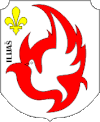Ilijaš
|
Ilijaš Илијаш |
||
|---|---|---|

View of the center of Ilijaš.
|
||
|
||
| Location in Bosnia and Herzegovina | ||
| Coordinates: 43°57′N 18°16′E / 43.950°N 18.267°ECoordinates: 43°57′N 18°16′E / 43.950°N 18.267°E | ||
| Country | Bosnia and Herzegovina | |
| Government | ||
| • Municipality president | Akif Fazlić (SDA) | |
| Area | ||
| • Total | 308,6 km2 (1,192 sq mi) | |
| Population (2013 census) | ||
| • Total | 20,504 | |
| • Density | 66,4/km2 (1,720/sq mi) | |
| Time zone | CET (UTC+1) | |
| • Summer (DST) | CEST (UTC+2) | |
| Area code(s) | +387 33 | |
| Website | http://ilijas.ba/ | |
Ilijaš (Илијаш) is a town and municipality located north-east of the inner city of Sarajevo in Bosnia and Herzegovina. It was established in May 1952 with the organization of people’s committees. Those local people’s committees founded the local municipalities, which led to self-management of the municipalities, including the municipality of Ilijaš.
In the early Middle Ages close to the river Bosna and Vogoščica the district Vogošća or Vidogošća was formed. Some later events that are tied to the Ottoman period came to the formation of džemats, nahiyahs and sanjaks. In the beginning of the nineteenth century there were 20 džemats in the Sarajevo Nahiyah: Butmir, Kijevo, Presjenica, Sudići, Trnovo, Zijamet Crna Rijeka, Pale, Mokro with Bobogovićima, Kriva Rijeka, Srednje, Čifluk Crna Rijeka, Rakova Noga, Vogošća, Nahorevo, Kulijes, Rakovica, Hadžići, Drozgometva, Pazarić and the villages of Luka i Žeravica.
The occupation of Bosnia and Herzegovina by the Austro-Hungarian Empire led to many changes which manifested to administrative and political changes. The territory of Bosnia and Herzegovina was divided into districts and further divided into counties. The counties were divided into municipalities, instead of dzemats, and they were furthermore divided into mahallahs and hamlets while the functions of the muhtars and village chiefs remained the same. The modern municipality of Ilijaš at that time was divided into the Sarajevo and Visoko counties and the boundary line between these two counties was the Povučje stream and the hill Bukovac which was between the stream and Ljubina.
The administrative division of Bosnia and Herzegovina until the formation of bans in 1929 remained the same even during the Austro-Hungarian occupation. Only after 1922 oblasts were formed instead of districts. Everything remained the same until 1941. Right after the freeing of the temporary national assembly of the Federal Bosnia and Herzegovina the assembly’s first session in August 1945 brought up the law of the territorial division of Bosnia and Herzegovina in districts, counties and areas of local people’s committees and their headquarters.
...
Wikipedia


